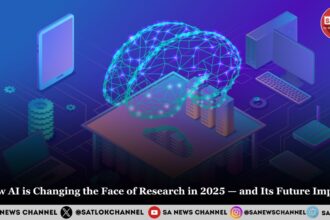Artificial Intelligence has erupted as one of the most disruptive forces of our time. Right from predicting the weather, to monitoring our sleep, to tracking our actions, AI has become almost unavoidable today. As the AI landscape keeps transforming every single day, what does the future of AI hold for us? This article analyses the future of AI, while providing an overview of how it affects us at various levels of life.
AI in Transition: Highlights
- IBM’s 2023 survey indicates that as many as 38% companies have adopted generative AI in their work systems. (Source)
- The global artificial intelligence market is currently estimated to be worth around $391 billion, with forecasts suggesting it could grow nearly fivefold within the next five years. (Source)
- Despite AI being increasingly embraced by companies worldwide, a significant problem expected to arise by 2026 is the exhaustion of available public data based on which large AI models are trained. (Source)
- While some experts opine that Artificial Intelligence has contributed to increased jobs and wages in the tech sector, there are contradictory reports as people are also losing their jobs due to AI, for example, data entry operators.
- Global economies are so invested in Artificial Intelligence that it is believed that Generative AI has the potential to contribute as much as $4.4 trillion to the global economy every year. (Source)
- India topped the Stanford AI Index 2024 in AI skill penetration, with talent growth up 263% since 2016. (Source)
Future of AI and Everyday Life
How AI has seamlessly integrated into our lives, is a widely acknowledged way of life today. Voice assistants like Siri and Alexa help manage daily tasks, while AI-curated recommendations soft-influence what we read, watch and buy. AI is also powering translation apps, our daily-use navigation tools and smart home devices.
AI tools like ChatGPT have almost become a way of life when it comes to extracting information, putting together a workout schedule or even a diet plan.
In the coming years, how far could AI go to further personalise services? However, such a high degree of personalisation brings serious privacy issues into focus. The more AI knows about us, the greater the potential for misuse of personal data by corporations, governments or malicious agents.
Despite the seemingly important role of AI in our everyday lives, none of the statistics and data prevalent today can exactly point out how AI will impact our normal everyday lives in future. Majority literature, forecasts and critique point either to AI major role in healthcare in future or the success of some industry.
However, none can pinpointedly say about AI’s impact on our daily lives in the years to come. One reason is also that humans are treated more as consumers, so the majority of the optimism is surrounding industries rather than ‘human needs’.
Ethical and Philosophical Challenges
Before we approach the future of AI and industries, as AI systems become more powerful, some important ethical questions need to be answered.
- Should AI have the right to make life-and-death decisions, such as in autonomous vehicles or military drones?
- Who should be held accountable if an AI system’s actions result in harm?
- What happens if AI systems exhibit bias, reflecting societal prejudices embedded in their training data?
- Deepfakes and AI-generated content blur the line between reality and fabrication, undermining trust in media.
- Algorithmic decisions in areas like hiring, lending and law enforcement can reinforce discrimination if not carefully managed.
Though this section should have had some inkling of how AI would penetrate our lives further by solving the ethical concerns around it, the reality is that there is no answer at all. The manner in which AI has emerged as a double-edged sword by promoting welfare and itself turning into an epicentre of distress, leaves little room to imagine future consequences.
Could AI systems ever become conscious in future and if so, what decision rights would they have? What does it mean to be human in an age where machines can emulate human creativity and conversation?
Future of AI and Industries
Artificial Intelligence (AI) has been integrated today in several industries such as healthcare, agriculture, defence systems, aviation, finance, manufacturing, and many more.
We will look into the most-impacted industry cases and how AI could shape the future of an industry.
Future of AI in Healthcare
AI in medical imaging, telemedicine and drug discovery is gaining traction. It is believed to lead to faster disease detection and offer more personalised treatment plans.
Also Read: Beyond the Hype: What the Numbers Say About AI in Business?
Diagnostic tools powered by AI are being reported to surpass most doctors in accuracy. But can this rule out human oversight completely in future? And, can AI-powered medical tools and robots replace human doctors and staff completely?
No. This can never happen. The medical fraternity sees AI more as a collaborator. Over the next five to ten years, healthcare is projected to shift from being reactive and generalised to proactive and highly individualised with AI playing the role of a collaborator at every stage.
- AI in Diagnosis: Artificial Intelligence can bring speed, possible accuracy and scale to treatments. AI systems can analyse medical images, such as X-rays, CT scans and MRIs, with greater accuracy, often matching or exceeding human radiologists in specific domains.
- For example: Deep learning models trained on thousands of retinal scans can now detect early signs of diabetic retinopathy with up to 90% accuracy. (Source)
- What to expect in the next 5-10 years? AI can become a core assistant for doctors, providing a ‘second opinion’. AI-powered diagnostics will be embedded not only in hospitals but also in specific wearables, mobile apps and point-of-care devices, making early intervention more accessible.
- Predictive Analytics and Preventive Care: By analysing vast datasets, such as medical histories, genetic profiles, wearable device data, environmental factors, etc., AI can forecast an individual’s likelihood of developing conditions like cardiovascular diseases, mental health disorders, neurodegenerative conditions (e.g., Alzheimer’s), or lifestyle-related illnesses like Type 2 diabetes.
- Hospitals and insurance companies are increasingly using AI to stratify risk levels.
- This shift in strategy from treatment to prevention could reduce hospital admissions.
- Virtual Health Assistants and Patient Monitoring: AI-powered chatbots and voice assistants are beginning to handle routine medical queries, schedule appointments, monitor patient recovery and even offer mental health support through conversational therapy.
- Additionally, wearables (like Apple Watch, Fitbit or medical-grade monitors) feed real-time data into cloud-based AI platforms that can track an individual’s blood oxygen levels, heart rate variability, sleep cycles, blood glucose fluctuations and stress indicators
Despite the positivity about the future of AI in healthcare, challenges and ethical considerations cannot be ignored.
The critical concerns that need to be addressed are:
- Bias in algorithms: If AI systems are trained on datasets that lack diversity, they may perform poorly for certain populations. This will ultimately lead to unequal care outcomes.
- Privacy and data security: Healthcare data is sensitive and vulnerable to cyberattacks. Strong government rules and frameworks may ensure the ethical use of data.
- Explainability of an AI-based diagnosis: Clinicians and patients alike need to understand how an AI system arrives at its conclusions and how trustworthy they are, especially when lives are at stake.
- Regulatory clarity: AI tools must pass stringent clinical validation before being integrated into medical decision-making.
As AI begins to share decision-making authority with doctors, ensuring accountability, fairness and human oversight is non-negotiable.
Future of AI in Education
The integration of Artificial Intelligence (AI) into education has its roots set in the use of technology for virtual classes during the COVID-19 pandemic. Over the next decade, AI is expected to transform traditional classrooms into more dynamic, personalised learning set-up that adapt to the needs of every student, irrespective of location, background or ability.
AI could transform the education industry as follows:
- Personalised learning for every student: One of the most projected benefits of AI in education lies in personalisation. AI tools can analyse a student’s performance in real time and tailor content to match their skill level, interests and learning gaps.
- AI-driven virtual tutors and intelligent chatbots are now helping students learn beyond classroom hours, offering instant academic support and guidance. These systems can answer queries and provide feedback 24/7. It helps bridge the gap between lessons and real-time support.
- Teachers could also benefit from AI assistants that can handle administrative tasks, such as correcting, attendance and reminders.
- AI-based learning can prove as a turning point for inclusive education, particularly for students with disabilities or those in inaccessible regions. For example, customised content for students with ADHD, dyslexia or autism.
- Content creation and curriculum design with AI: AI is increasingly becoming a partner in creating educational material. For example, it can be used to generate lesson plans, tutorials and quizzes within minutes.
Despite so many promises, integrating AI into education has some important challenges:
- Data privacy continues to remain one of the biggest threats of AI.
- Bias in algorithms: If training data is skewed, AI will in all likelihood propagate inequalities too.
- Excessive dependence on AI could limit meaningful human interaction, diminishing opportunities for empathy, face-to-face communication and social development.
Future of AI in Finance
From predicting market trends to detecting fraud, AI is being utilised heavily in the modern finance systems. Over the next 5 to 10 years, experts believe the financial services sector will see a sharp shift toward AI-powered decision-making, hyper-personalisation and automation.
While AI may enhance efficiency, reduce human error and open up financial services to more people, it also introduces new ethical, regulatory and cybersecurity challenges as is always the case with AI technology.
- Smarter banking and customer service: Banks are embracing AI to offer more responsive, data-driven customer experiences.
- AI chatbots and virtual assistants are now resolving customer queries, even opening accounts and offering financial advice without human intervention for basic banking processes.
- AI could be used in future to provide proactive alerts to help users avoid overdrafts, plan bills or spot unusual transactions
- Fraud detection and risk management: AI is being used in the fight against financial crime. By analysing billions of transactions in real time, machine learning models are now able to detect anomalies, patterns and behavioural signals for detecting fraud.
- This means AI could be used in anti-money laundering (AML) systems to flag suspicious activity instantly.
- Artificial Intelligence can also be used to check credit risk scoring, where it predicts the probability of default based on vast data sets and not just credit history. It will also analyse social behaviour and purchase trends.
- Inclusion of AI-powered technology in finance could lead to hyper-personalised financial products. For example, flexible loan offers adapted to real-time income patterns or employment shifts may help consumers better as per their needs.
As promising as AI in finance is, it comes with serious caveats that cannot be ignored:
- Data Privacy: The more personalised the service, the more data is collected. The biggest question will be ensuring secure storage, ethical usage of data and user consent for data.
- Cybersecurity: With increasing financial frauds reported each day, despite the deployment of AI in finance, financial systems that are AI-dependent are also more vulnerable to AI-powered cyberattacks or data breaches.
- Job Displacement: Routine jobs like tellers, analysts and even junior accountants could be automated. While AI creates new roles (like data ethics officers, AI risk analysts), the transition could be turbulent without reskilling efforts.
Future of AI in Agriculture
As the global population continues to grow, agriculture faces immense pressure to produce more food using fewer resources. In such a scenario, experts believe that the deployment of Artificial Intelligence in agriculture can bolster food growth.
- AI is already helping farmers to make informed decisions about every square metre of land. With the help of satellite data, drones, sensors and AI-powered analytics, precision agriculture allows for optimised seed placement and planting schedules. It also helps in accurate fertiliser and pesticide application, real-time weather monitoring and yield prediction.
- Instead of treating fields uniformly, AI systems analyse data to treat different parts of a field differently. This helps improve output while reducing waste.
- Crop diseases pose a major risk to global food security, making early detection and continuous crop monitoring essential for sustainable agriculture. AI models that are trained on thousands of images and datasets can detect signs of disease or pest infestation early.
- Drone and satellite imagery powered by AI can track crop health.
- Machine learning algorithms analyse soil conditions, leaf patterns and weather to forecast outbreaks of diseases.
- Automated farm machinery: Self-driving tractors, robotic harvesters and automated weeders are being used as the next generation of farm equipment.
- The use of AI can help agriculture become more environmentally sustainable in several ways such as reducing chemical usage through precise application and conserving water via smart irrigation systems that adjust to soil moisture and weather.
However, the biggest downside of use of advanced AI tools in agriculture is the significant investment in hardware, connectivity and training. Small-scale farmers may not be able to afford such high end equipment. Aside from this, there are repeatedly similar concerns emerging from the integration of AI technology in farming practices:
- Data Ownership: Farming data such as soil health, yield patterns and land productivity is extremely valuable. Questions remain over who owns this data – the farmer, the tech company or the government?
- Loss of traditional knowledge: As AI begins to dictate farming practices, there’s a risk of sidelining generations of indigenous and local agricultural wisdom.
- Job Displacement: Automation in large-scale farming could reduce the need for manual labour. This will undoubtedly affect livelihoods in rural areas.
Future of AI in Customer Service
Customer service has traditionally been the human face of a company. It is that point where questions are answered, issues are resolved and consumer trust is built. But with rising customer expectations and increasing demand for 24/7 support, traditional models seem to need a push. This is where Artificial Intelligence comes in the customer service sectors.
AI chatbots, voice assistants, predictive analytics, and sentiment analysis are being utilised by companies to serve their consumers in the following ways:
- AI-powered chatbots are already replacing or augmenting traditional customer service agents in many industries. These bots can answer FAQs instantly, guide customers through purchases or support complaint tickets. They also help in escalating complex queries to human agents when needed or as per the process devised by the company.
- Online retailers giants like Amazon and Flipkart are prominent examples of using AI chatbots for consumer queries.
- One of AI’s biggest advantages in customer service is its ability to sift through massive datasets to personalise customer experiences.
- AI systems can recommend products or solutions tailored to the user for a more personalised treatment.
- AI-powered systems can also predict what a customer may need before they even ask
One of the main hurdles in applying AI to customer service is its inability to truly understand or express human empathy. Many times, it leaves customers frustrated rather than satisfied with the solution offered.
Future of AI and Creativity
One of the most fascinating developments is AI’s growing creative potential. AI systems can compose music, write stories, generate art and even design products or websites. Tools like large language models and generative AI platforms allow anyone to create complex content with minimal technical expertise.
In the future, AI might act as a creative partner, helping artists, writers and designers explore new ideas. On the positive side, it has the potential to make creativity more accessible by reducing the obstacles that traditionally limit participation.
However, this sparks debate about who should be credited as the creator. When AI generates a painting, who actually owns the copyright? What happens to human creativity when machines can mimic it so convincingly?
Future of AI in India
India, with its massive population, growing digital infrastructure and a thriving startup ecosystem, seems uniquely positioned to harness AI technology for both economic growth and social impact.
- Government initiatives like ‘Digital India’, ‘Make in India’ and ‘IndiaAI Mission’ are pro research, innovation and the adoption of AI across the country.
- India’s push towards indigenous AI models, multilingual language tools and ethical AI frameworks reflects a conscious effort to ensure that AI technology reaches most corners of the country.
India’s AI Revolution National Strategy
As per a PIB press release, dated 6th Mar 2025, the Government of India has launched several AI-centred initiatives as part of its Viksit Bharat movement:
- The central government launched the IndiaAI Mission with a INR 10,300 crore-budget over five years.
- A centralised high-performance computing infrastructure has been set up with 18,693 GPUs, placing it among the leading national AI systems globally.
- India is also developing a domestic GPU with the aim for independence from global chip suppliers within 3-5 years.
- India looks to democratise AI infrastructure by offering affordable, high-end computer access to startups, students and researchers through an open GPU marketplace, breaking monopolies held by Big Tech.
- To support this move, a robust GPU supply chain has been established by selecting 10 supplier companies.
- The IndiaAI Dataset Platform provides a vast collection of anonymised, non-personal datasets critical for training inclusive, unbiased AI models.
- The government has also set up a Centre of Excellence (CoEs) in AI for Healthcare, Agriculture and Sustainable Cities. Furthermore, it has announced a fourth in Education. This CoE is backed by an INR 500 crore-budget allocated in the 2025 budget.
- IndiaAI is fostering the development of home-grown foundational AI systems, such as Large Language Models (LLMs) and their smaller-scale counterparts (SLMs).
- ‘Bhashini’ facilitates sophisticated speech and translation services across various Indian languages.
- ‘BharatGen’, launched in 2024, is India’s first multimodal LLM built for public service in speech, vision and text.
- ‘Sarvam‑1’, a 2 billion-parameter LLM supporting ten Indian languages, was also introduced by India.
- Additional tools like ‘Chitralekha’ (video transcreation) and ‘Everest 1.0’ (supporting 35 languages, expanding to 90) showcase India’s multilingual AI investments.
- AI is also being embedded into India’s DPI, such as Aadhaar, UPI and DigiLocker.
- India is rapidly building domestic AI capabilities, revamping curricula under NEP 2020 to include AI, 5G and chip design.
- Initiatives like IndiaAI FutureSkills and Data Labs in Tier 2/3 cities aim to foster AI literacy.
- Speaking at the Future Frontiers Forum held at the Science Museum in London on 19th June 2025, Union Minister Piyush Goyal highlighted India’s strong commitment to embracing AI, expressing confidence that employment concerns would not hinder its adoption. He also reiterated that AI will create more jobs
The bigger question here is, irrespective of the country, is AI truly aiding us so much that we can overlook the grave security concerns it brings?
Why Has Technology Boomed Only Now?
Why is it that humans consistently turn to technology as the ultimate fix for problems? From Artificial Intelligence to automation, we chase every new breakthrough with the hope that it will ease our burdens. And yet, ironically, this very same technology often deepens the complexity of our lives – isolating us, consuming our attention and sometimes, even replacing our natural human instincts with code.
Despite the harm it causes, we remain enamoured and enchanted by its speed, efficiency and the seeming omnipotence. But in our blind pursuit, have we ever paused to ask: Is there truly a solution to all of life’s sufferings?
Yes, there is, but it lies far beyond algorithms and data.
Jagatguru Tatvdarshi Sant Rampal Ji Maharaj offers a revolutionary insight. Technology is not man’s invention, it is actually a gift from God. It is not the result of intellectual superiority but the unfolding of a divine plan by Supreme God Kabir.
To those who doubt this truth, simply ask – Why has technology exploded only in the last few decades, while humanity has existed for thousands of years without it? If it were merely a product of human evolution, why didn’t it emerge in earlier civilisations?
The answer is profound and unfathomable. Technology is being accelerated now because the time has come to reveal true spiritual knowledge to every soul on Earth. It is not meant to be exploited in every corner of life but to serve a higher spiritual purpose: to make the truth about creation, salvation and the real Supreme God universally accessible.
This truth is rooted deeply in our ancient scriptures, and shines a light on the only real solution to human misery. Not in machines, not in code, but in the eternal wisdom of God-realisation.
Until we understand this divine intent, technology will remain a double-edged sword. But once aligned with spiritual truth, it becomes a powerful servant in the mission of liberating humanity from the vicious cycle of suffering itself, not from superficial discomforts of life.
Science Above God? The Fatal Mistake of Modern Civilisation
Jagatguru Tatvdarshi Sant Rampal Ji Maharaj unveils the real truth hidden behind humanity’s obsession with science and technology – our relentless pursuit of innovation has stripped us of morality, empathy and the very essence of spiritual understanding.
In our arrogance, we have committed the gravest mistake. We have placed science above God and drifted away from the actual divine path. We have forgotten our Creator and traded eternal truth for temporary convenience.
But this unfolding technological era is not without purpose. Sant Rampal Ji Maharaj reveals that Supreme God Kabir has orchestrated this divine phase, allowing technology to flourish, not to deepen our material entrapment, but to become the very channel through which His eternal spiritual knowledge reaches every soul on Earth.
Let this be clear – No innovation, no AI breakthrough, no digital marvel can ever take the place of true worship of God Kabir. The cure for human suffering is not coded in machines, instead, it lies in devotion under the guidance of Sant Rampal Ji Maharaj, the living embodiment of God Kabir on Earth today. Sant Rampal Ji Maharaj is the Satguru (True Guru) whose knowledge alone can liberate us from this ocean of sorrow.
But why is human life so painful? Why do we continue to chase failed solutions? Why are we blind to the truth that has been in front of us all along?
Because we’ve forgotten why we were sent here. We’ve been exiled into this suffering world due to our own spiritual disobedience and this truth has been buried under layers of illusion and false beliefs.
Now is the time to awaken and question the truth of our existence. Watch this life-transforming video by Sant Rampal Ji Maharaj and uncover the greatest hidden truth of human life and how we arrived on Earth:
FAQs
Q1: What is the future of AI technology?
Answer: Though experts tout the future of AI as very significant, the increasing amount of problems it brings with it cannot be ignored.
Q2: Is AI safe for the future?
Answer: AI is not safe even now, and neither is there a concrete solution yet for the massive data and security breaches we face.









